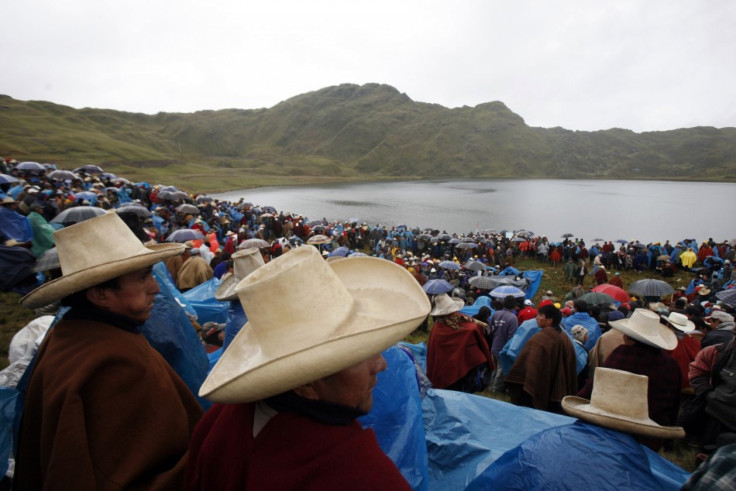Peru's Leftists Criticize Leftist Pres. Ollanta Humala

(REUTERS) -- Foes of the biggest mining investment in Peruvian history accused President Ollanta Humala on Thursday of abandoning his leftist roots to support Newmont Mining's proposed $4.8 billion Conga gold mine.
Harsh words from local leaders in the Andean region of Cajamarca highlighted Humala's struggle to neutralize Peru's polarized political environment and govern as a moderate who can simultaneously help the poor and please big business.
I think the president is being pressured by transnational capital and people are now asking him to return to his original policy platform, Gregorio Santos, the president of the Andean region of Cajamarca, said at a rally against the mine.
In his earlier days as a politician, Humala called for a radical overhaul of Peru's free-market economic model.
But the former military officer shed that platform as this year's election campaign progressed and moved toward the political center, recasting himself in the soft-left vein of Brazil's respected former president Luiz Inacio Lula da Silva.
Humala lured votes from wealthier Peruvians with that strategy but ended up frustrating some of his traditional supporters on the left and in rural provinces.
We voted for something else, Santos said near the mine 13,800 feet (4,200 meters) high in the Andes.
More than two thousand largely peaceful protesters marched on Thursday in the city of Cajamarca and 100 miles (160 km) away at lakes where the mine would be built. Some villagers arrived on horseback at the mine site, where a few tore down signs that said Minas Conga and burned a stockpile of plastic pipes, though no injuries were reported.
Protesters and farmers say the mine would cause pollution and hurt water supplies by replacing a string of alpine lakes with artificial reservoirs.
We are going to continue protesting because they are going to destroy our lakes, said Jose Marin, the mayor of the district of Huasmin.
U.S.-based Newmont says its environmental plan, which was approved a year ago by the previous government, adhered to rigorous standards and included input from local communities. It also has said the mine would generate thousands of jobs.
The company, which didn't comment on what Santos said, halted work on the project on Thursday as a precaution while police and security officers protected earth-moving equipment, some of which was vandalized in previous protests.
Aides to Humala, who took office in July, have said the environmental plan is sound and made clear that the mine would become a lucrative source of tax revenue for the country.
The Conga dispute has dragged on for weeks and become a crucial test for Humala, who campaigned on promises to defuse persistent social conflicts over natural resources that have delayed billions of dollars in investments in the country, one of the world's top minerals exporters.
The conflicts turned violent during the term of Humala's predecessor, Alan Garcia, when 195 people were killed in clashes with police, according to Peru's human rights agency.
Humala has sought to avert violence by emphasizing mediation efforts between local communities and companies.
Though he railed against foreign capital when he first ran for president in 2006, he now courts investment, telling business leaders Peru is a land of opportunity.
He has also rolled out social programs and raised taxes on mining companies to spread the wealth from a decade-long economic boom to the one third of Peruvians mired in poverty.
The Conga project, which Newmont owns with Peruvian precious metals miner Buenaventura, would produce 580,000 to 680,000 ounces of gold a year and open in 2014. It has gold deposits worth around $15 billion at current prices.
Nearby sits Newmont's existing Yanacocha mine, which produced 1.5 million ounces of gold last year. Newmont has faced opposition to its expansion plans in the past. In 2004 it halted exploration to expand Yanacocha to include Cerro Quilish, a nearby mountain, because of community protests over water supplies.
© Copyright Thomson Reuters 2024. All rights reserved.












